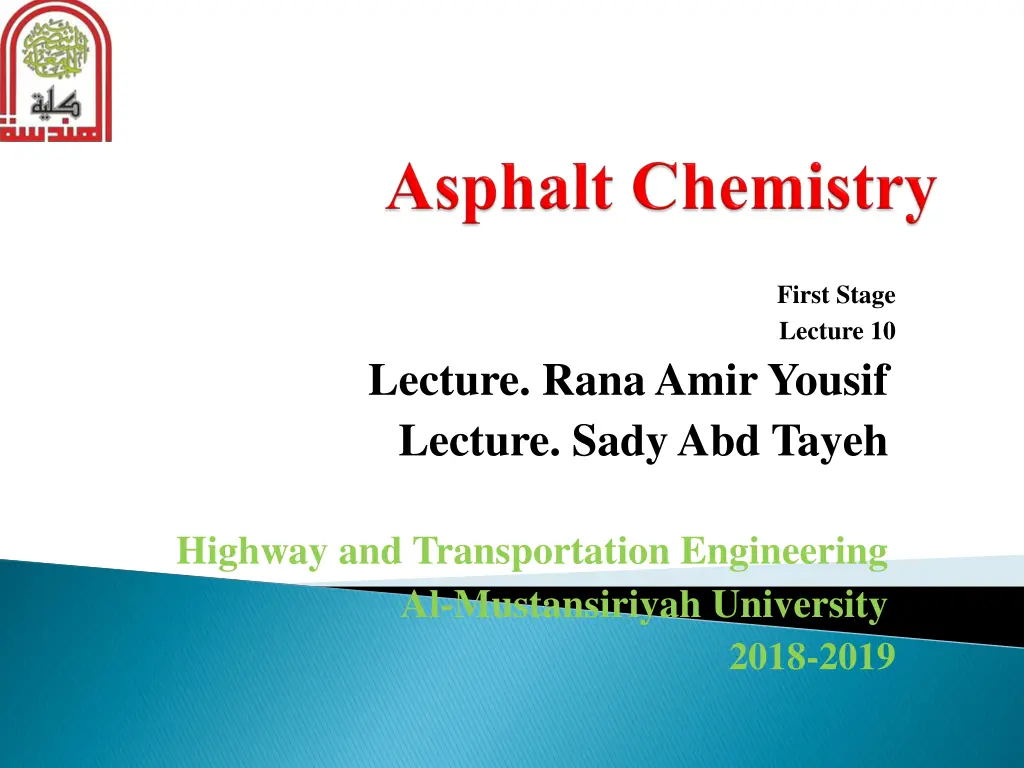
Chemical Composition and Performance of Asphalt in Highway Engineering
Explore the relationship between chemical composition and performance of asphalt binders in highway pavements. Understand the impact of elemental composition and molecular structures on physical properties, including the significance of heteroatoms and functional groups.
Download Presentation

Please find below an Image/Link to download the presentation.
The content on the website is provided AS IS for your information and personal use only. It may not be sold, licensed, or shared on other websites without obtaining consent from the author. If you encounter any issues during the download, it is possible that the publisher has removed the file from their server.
You are allowed to download the files provided on this website for personal or commercial use, subject to the condition that they are used lawfully. All files are the property of their respective owners.
The content on the website is provided AS IS for your information and personal use only. It may not be sold, licensed, or shared on other websites without obtaining consent from the author.
E N D
Presentation Transcript
First Stage Lecture 10 Lecture. Rana Amir Yousif Lecture. SadyAbd Tayeh Highway and Transportation Engineering Al-Mustansiriyah University 2018-2019
References: Edwin J. Barth. Asphalt Science and Technology , 1st Ed. ,1962. James Speight Asphalt Materials Science and Technology , 1st Edition 2015.
The Relationship between Chemical Composition and asphalt performance The performance of asphalt as a binder in HMA pavements is determined by its physical properties which in turn are determined directly by chemical composition. An understanding of the chemical factors affecting physical properties is fundamental to an understanding of the factors that control asphalt performance. Elemental Composition and Molecular Structure Carbon and hydrogen: are the principal elements present in asphalt cement molecules. Sulfur: is the next most abundant element. Nitrogen and oxygen: are usually present in very small amounts. Heavy metals such as vanadium and nickel: may also be present in trace amounts.
Heteroatoms: they are chemical atoms consisting sulfur, nitrogen and oxygen. Most asphalt molecules consisting of carbon and hydrogen contain one or more of the heteroatoms . The type of molecular structure is more important than the total amount of each element. Asphalt cements contain a combination of the following three arrangements by which the carbon atoms are linked with each other: Straight or branched chains. Such asphalt cements are generally called "aliphatic" or "paraffinic" types. 1.
2. Simple or complex saturated rings. "Saturated" means the highest possible hydrogen/carbon ratio in the asphalt molecules. These asphalt cements are usually referred to as "naphthenic" types. 3. One or more stable six-carbon condensed, unsaturated ring structures. These asphalt cements are called "aromatic" types. Benzene and naphthalene have such structures.
Functional or Polar Groups : Heteroatoms (sulfur, nitrogen and oxygen) are attached to carbon atoms in asphalt molecules in different configurations and in form of different compounds. These configurations (molecules) are polar because there is an imbalance of electrochemical forces within the molecule which produces a dipole. These configurations of heteroatoms thus impart functionality and polarity to asphalt molecules and are therefore called functional or polar groups. Functionality (presence of function groups) relates to how the asphalt molecules interact with each other or with surfaces and/or molecules of other materials.
Non-polar components: Also, the non-polar components of asphalt cement, which act as solvents or dispersants for the polar or functional groups, play a major role in determining the effect that the polar groups will have on the physical and aging properties of the asphalt cement.






















